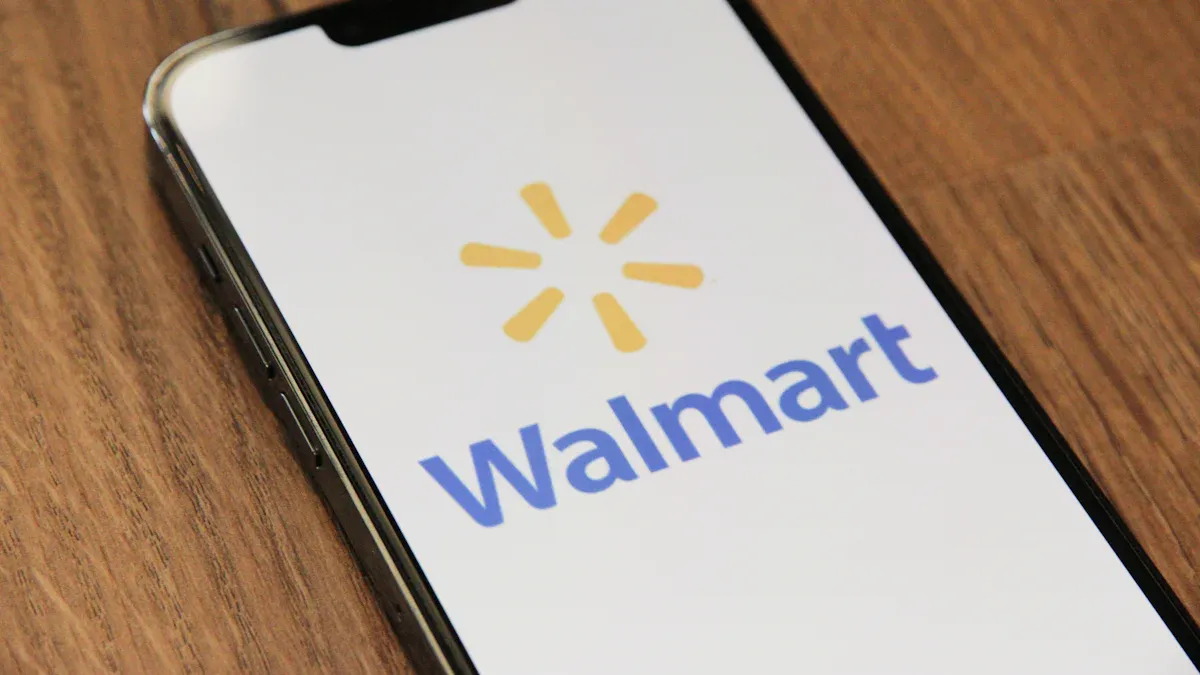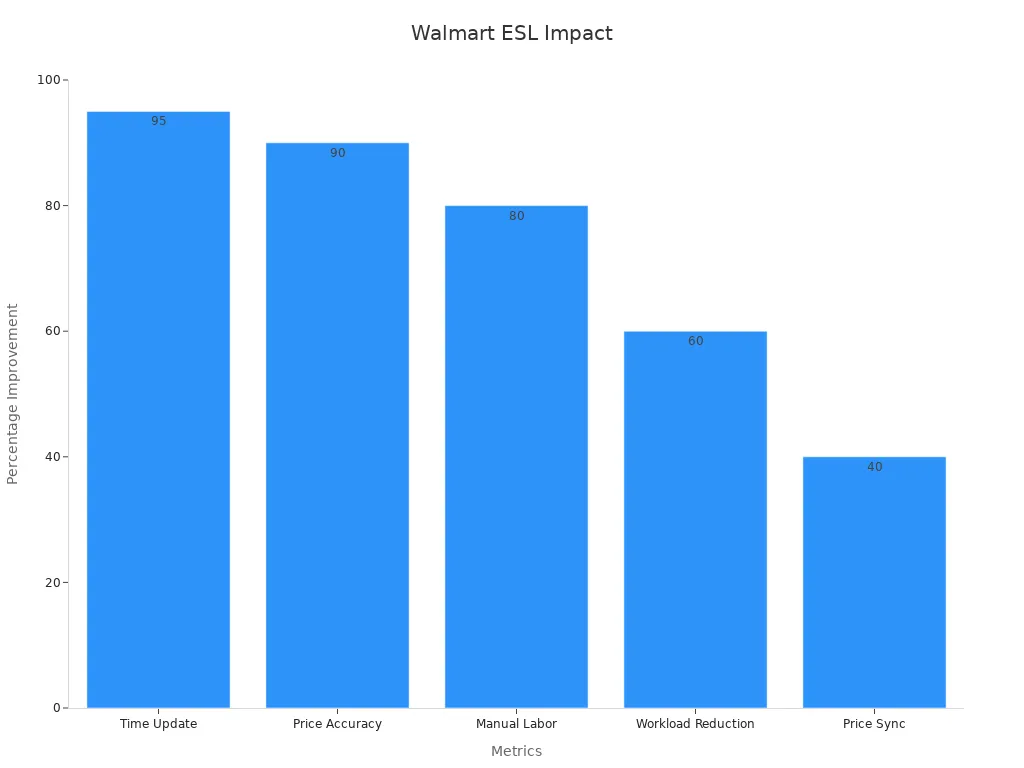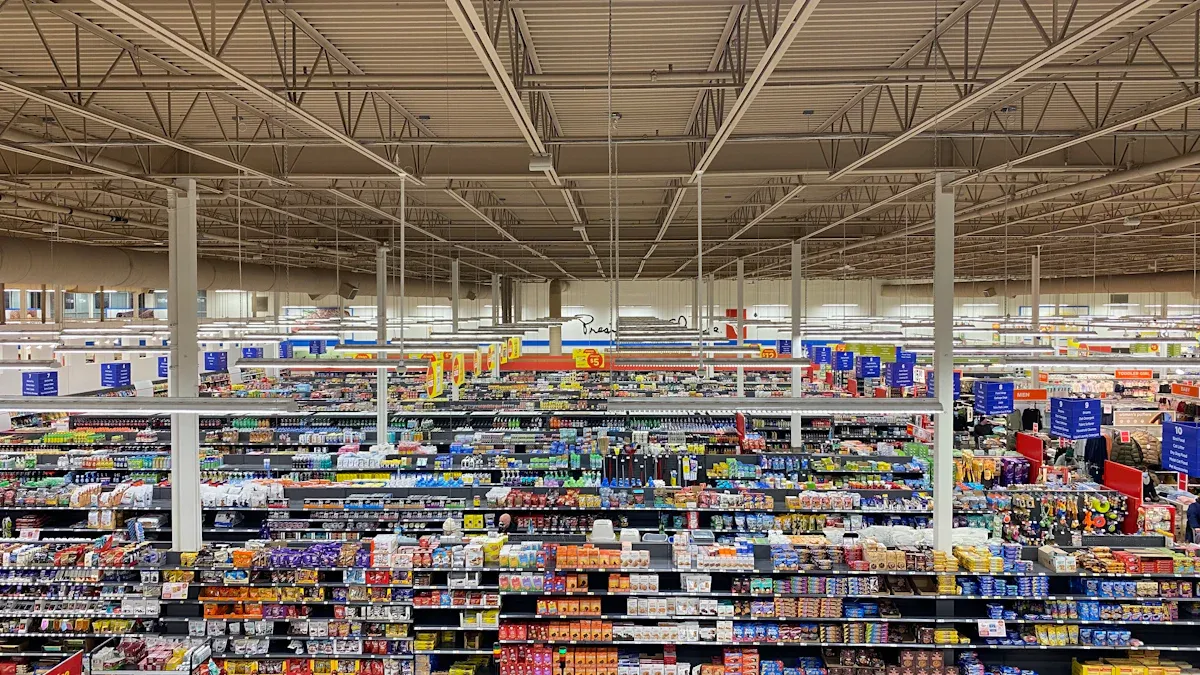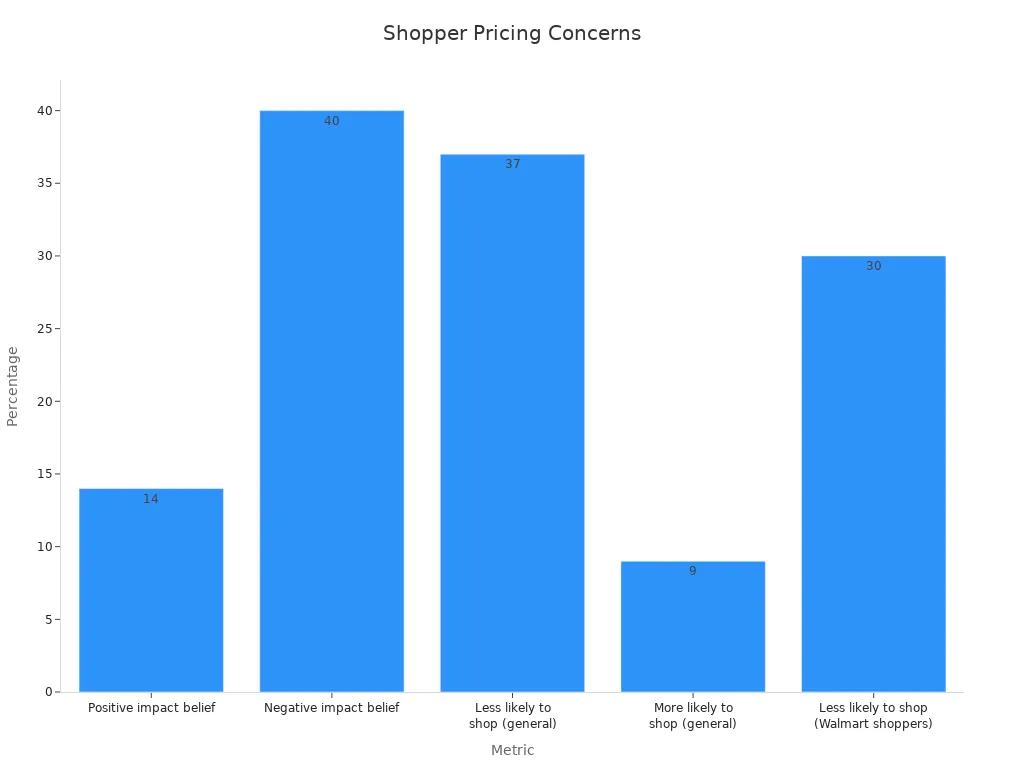
You now see Walmart stores transforming how you view and interact with price tags. Digital price tags, powered by Electronic Shelf Labels and the ESL Gateway AP, allow you to spot real-time updates and accurate prices in grocery aisles. With this technology, Walmart reduces price update times by 95% and achieves over 90% price accuracy, nearly eliminating manual errors.

As you shop, ESL Price Tag and Esl Retail systems make daily updates possible, replacing slow, paper-based changes. Walmart’s digital system now covers thousands of items, improving your experience and efficiency across every visit.

Walmart Digital Price Tags: What Shoppers Need to Know

How Digital Price Tags Work at Walmart
Electronic Shelf Labels and Real-Time Updates
You now see a major shift in how Walmart manages pricing in stores. Electronic shelf labels have replaced traditional paper tags, bringing a new level of efficiency and accuracy. These digital labels display prices on small screens attached to shelves, allowing you to view up-to-date information every time you shop.
- Price changes that once took days now happen in minutes.
- Walmart employees use a mobile app to update prices, eliminating the need to manually swap out paper tags.
- The merchant team sends price updates, which appear instantly on the shelf.
- LED lights on the labels help associates quickly find products for restocking or order fulfillment.
This system not only keeps prices current but also improves inventory management. You benefit from fewer pricing errors and more reliable promotions. The Pick to Light feature, which uses flashing LEDs, guides employees to the right shelf, speeding up both stocking and online order preparation.
Note: Walmart and other major retailers have stated that this technology does not enable dynamic pricing or facial recognition-based adjustments. You can shop with confidence, knowing that prices remain stable and transparent.
The VusionGroup and VusionCloud System
Walmart partners with VusionGroup to power its digital price technology. The VusionCloud platform connects each electronic shelf label to a central system. This cloud-based approach allows Walmart to manage thousands of price updates across the store with just a few clicks.
- The system automates price and inventory management.
- Employees can focus more on customer service, as the technology reduces manual labor.
- The platform ensures that promotions and discounts are always accurate and visible to you.
You experience a smoother shopping trip, with less confusion at checkout and more consistent pricing throughout the store.
Where You’ll See Digital Price Tags in Walmart Stores
Rollout Timeline and Store Coverage
Walmart plans to expand digital price tags to 2,300 stores by 2026. You may already notice these labels in select locations, especially in high-traffic areas. The rollout focuses on improving operational efficiency and environmental impact, as digital labels reduce paper waste and save time for employees.
- Over 120,000 products in each store can now receive instant price updates.
- Economic experts confirm that this change will not increase grocery bills for most customers.
Beyond Shelves: Apparel Racks and More
You will find digital price tags not only on grocery shelves but also in other departments. Walmart extends this technology to apparel racks, electronics, and seasonal displays. This broad coverage ensures that you always see the most accurate price, no matter where you shop in the store.
- Digital labels appear on endcaps, promotional bins, and specialty sections.
- The technology adapts to various product types, making your shopping experience more consistent.
With digital price tags, Walmart delivers a modern, efficient, and reliable way for you to shop, whether you are looking for groceries, clothing, or electronics.
Key Benefits of Digital Price Tags for Walmart Shoppers

Accurate and Up-to-Date Pricing
Eliminating Price Discrepancies
You expect the price you see on the shelf to match what you pay at checkout. Digital labels make this possible by connecting directly to Walmart’s pricing system. Wireless connectivity and integration with point-of-sale systems ensure that shelf prices always match the register. This technology nearly eliminates pricing errors, which have dropped by 98% in grocery chains using electronic shelf labels. You benefit from fewer surprises at checkout and greater trust in the store’s pricing integrity.
| Metric Description | Numerical Improvement |
|---|---|
| Reduction in pricing errors in grocery chains | 98% reduction |
| Decrease in product return rates at Walmart | 25% decrease |
| Time to complete price changes at Walmart | From days to minutes |
You see fewer disputes and returns, making your shopping experience smoother and more reliable.
Faster Price Adjustments for Sales and Promotions
You no longer wait days for new sales or promotions to appear on the shelf. Digital labels allow Walmart to update prices in minutes, not days. This rapid adjustment means you can take advantage of deals as soon as they go live. The system also supports real-time changes based on demand or external factors, such as adjusting umbrella prices when it starts raining. You always see the most current price, whether you shop early in the morning or late at night.
Tip: Check the shelves frequently during major sales events. You may spot new discounts or flash promotions that appear instantly thanks to digital price tags.
Easier Access to Deals and Discounts
Instant Highlighting of Special Offers
You find it easier to spot deals in the aisles. Digital labels can highlight special offers with icons, colors, or flashing lights, drawing your attention to discounts and promotions. This feature helps you quickly identify the best prices without searching through paper tags or missing out on limited-time offers. The immediacy of updates ensures that you never miss a deal because of outdated information.
Potential for Personalized Pricing and Promotions
As digital price tags evolve, you may see more personalized offers tailored to your shopping habits. The technology supports dynamic pricing, which allows Walmart to adjust prices based on demand, inventory, or even your preferences. While this feature primarily benefits the retailer, it can also lead to more competitive pricing and timely discounts for you. You might receive targeted promotions or loyalty rewards that appear directly on the shelf label, making your grocery trip more rewarding.
- You get access to deals that match your needs.
- The system responds quickly to market trends and competitor pricing.
- You benefit from a more dynamic and responsive shopping environment.
Enhanced In-Store Shopping Experience
Clearer, Easier-to-Read Price Tags
You notice that digital labels offer high-contrast displays, making prices easier to read from a distance. This improvement reduces confusion and helps you make faster decisions in the grocery aisle. Survey data shows that 72% of consumers prefer stores with clear, digitalized pricing, and 68% feel more confident when prices are displayed digitally. You experience less frustration and more confidence as you shop.
Smoother Checkout and Less Confusion
You enjoy a faster, more efficient checkout process. Digital price tags ensure that the price you see on the shelf matches what you pay at the register, reducing disputes and delays. Case studies reveal that digital labels lead to fewer customer complaints and faster checkout times. The automatic updates and clear displays build trust and loyalty, making your overall shopping experience more enjoyable.
Note: Digital price tags not only improve accuracy but also free up staff to assist you, as employees spend less time changing paper labels and more time helping customers.
You benefit from a modern, streamlined shopping experience that prioritizes accuracy, convenience, and satisfaction.
Potential Drawbacks and Concerns with Walmart Digital Price Tags
Dynamic Pricing and Price Fluctuations
What Dynamic Pricing Means for Shoppers
You may wonder how digital price tags could affect your shopping experience, especially when it comes to dynamic pricing. Dynamic pricing uses algorithms to adjust prices based on factors like demand, inventory, and competitor activity. This approach can lead to frequent price changes, sometimes even within the same day. Many shoppers express concern about this practice, fearing it could make it harder to predict the best time to buy.
| Shopper Concern Metric | Percentage | Description |
|---|---|---|
| Positive impact belief | 14% | U.S. adults who think digital price tags would positively affect their shopping experience |
| Negative impact belief | 40% | U.S. adults who think digital price tags would negatively affect their shopping experience |
| Less likely to shop (general) | 37% | U.S. adults less likely to shop at a retailer after digital price tag transition |
| More likely to shop (general) | 9% | U.S. adults more likely to shop after the transition |
| Less likely to shop (Walmart shoppers) | 30% | Walmart shoppers less likely to shop after digital price tag implementation |
| More likely to shop (Walmart shoppers) | ~30% | Walmart shoppers more likely to shop after the transition |
| Correlation with dynamic pricing concern | Strong | Consumers less likely to shop with digital price tags also tend to avoid brands using dynamic pricing |

These numbers show that a significant portion of shoppers feel uneasy about the potential for unpredictable price changes, even though Walmart has stated it does not use digital price tags for dynamic pricing.
How Frequently Prices May Change
You might notice that digital price tags enable rapid price updates. In markets where dynamic pricing is active, algorithms can change prices several times a day. These systems analyze data such as competitor prices, supply and demand, and sales history. Real-time dashboards and mobile apps allow managers to adjust prices instantly. While Walmart currently uses digital price tags for efficiency and accuracy, the technology could support more frequent price changes in the future if company policy shifts.
- Market volatility metrics track how often prices move.
- Algorithmic engines process large datasets to update prices.
- Machine learning models predict trends and adjust pricing.
- Price optimization software tests different price points.
- Mobile tools let managers change prices at the shelf.
Privacy and Data Use at Walmart
Shopper Data and Personalized Offers
You may have concerns about how your data is used with digital price tags. Walmart has publicly stated that its digital shelf labels do not collect or use customer data for personalized pricing. The system focuses on operational efficiency, such as faster price updates and better inventory management. Features like ‘Stock to Light’ and ‘Pick to Light’ help employees restock and fulfill orders, but do not track individual shoppers.
Balancing Convenience with Privacy Concerns
You benefit from more accurate pricing and a smoother shopping experience, but privacy remains a topic of discussion in the retail industry. Walmart has denied any plans to use digital price tags for dynamic pricing or to link them with facial recognition or customer profiling. Industry experts and studies confirm that, while skepticism exists, there is no direct evidence of Walmart using consumer data for personalized pricing through digital tags. The Federal Trade Commission continues to monitor the industry, but Walmart maintains that its system is designed for efficiency, not data exploitation.
Note: While privacy concerns are valid, current evidence shows that Walmart’s digital price tags focus on operational improvements rather than customer data collection.
Impact on Walmart Employees and Service
Changes in Staffing and Job Roles
You will see that digital price tags automate many manual tasks, such as updating prices. This shift allows employees to focus on higher-value activities, including customer service and product replenishment. As a result, staff can respond more quickly to your questions and keep shelves stocked more efficiently.
- Employees spend less time on repetitive tasks.
- Staff roles shift toward customer engagement and store upkeep.
- The store benefits from faster promotional changes and fewer pricing errors.
Effects on Customer Service and Store Operations
You experience more consistent pricing and better promotional execution. Digital price tags reduce confusion at checkout and help employees manage markdowns more effectively. Retailers track improvements in labor hours saved, pricing accuracy, and customer engagement. Although the technology changes some job roles, it often leads to a better in-store experience for you.
How to Make the Most of Walmart’s Digital Price Tags
Spotting the Best Deals in Real Time
Tracking Price Changes on the Shelf
You can take advantage of Walmart’s digital price tags by paying close attention to the shelves during your shopping trips. E-Ink electronic shelf labels, which Walmart uses, offer excellent readability under all lighting conditions. This means you can easily spot updated prices, even in brightly lit grocery aisles or dimmer corners of the store. These labels also feature high durability and long battery life, so you rarely encounter blank or malfunctioning tags.
- Look for flashing lights or icons on digital tags, which often highlight special offers or limited-time discounts.
- Check endcaps and promotional bins, as these areas frequently display updated prices and new deals.
- If you notice a price change while shopping, you can trust its accuracy, since the system updates in real time.
Tip: If you see a price update on the shelf, you can expect the same price at checkout, reducing confusion and saving you time.
Using Walmart Apps and Digital Tools
You can further enhance your shopping experience by using Walmart’s mobile app and digital tools. The app often syncs with in-store pricing, allowing you to scan barcodes and verify current prices instantly. Many shoppers use the app to access personalized offers, digital coupons, and loyalty rewards. Retailers like Kroger have seen a significant increase in app-based transactions when integrating personalized deals, and Walmart’s app continues to expand these features.
- Scan product barcodes to confirm the latest price and check for additional discounts.
- Use QR codes on product packaging to access recipes or product information, which can help you discover new grocery items and increase your savings.
- Enable notifications for flash sales or exclusive app-only promotions.
Understanding and Timing Price Changes
When to Shop for the Best Price
You can optimize your savings by understanding when Walmart updates prices. Digital price tags allow for near-instant changes, especially during major sales events or when inventory shifts. Walmart’s real-time retail data captures these changes at both the regional and store level. By shopping during off-peak hours or right after new promotions launch, you increase your chances of finding the best deals.
- Monitor weekly ads and app notifications for clues about upcoming price drops.
- Visit the store early in the day or after advertised sales begin to catch fresh discounts.
Recognizing Patterns in Discounts and Promotions
You can spot patterns in Walmart’s pricing and promotions by observing how digital tags change over time. Brands and retailers use SKU-level and location-specific data to adjust prices and launch promotions strategically. For example, electronics may see heavy discounts during back-to-school season, while grocery items might feature special pricing around holidays.
- Track which departments update prices most frequently, such as electronics or seasonal grocery sections.
- Watch for recurring promotions tied to events like Earth Month or regional celebrations.
- Use the Walmart app to compare historical prices and identify the best times to buy.
Note: Consistent monitoring of digital price tags and app updates helps you make informed decisions and maximize your savings.
Walmart Digital Price Tags and Online Shopping
Syncing In-Store and Online Prices
Real-Time Price Matching Policies
You expect consistency when comparing prices in-store and online. Walmart uses advanced AI systems to synchronize pricing across both channels. This technology analyzes demand, competitor pricing, and regional trends to keep prices aligned. Electronic price tags in stores connect with Walmart’s digital platforms, allowing you to see the same price whether you shop on the website or in person. The Me@Walmart mobile app enables instant updates, so you benefit from real-time price matching policies. This approach reduces confusion and helps you make informed decisions.
- AI-driven pricing ensures product availability and competitive pricing in your local market.
- Electronic price tags update instantly, reflecting changes made online or in-store.
- Dynamic pricing strategies help Walmart stay competitive while maintaining operational efficiency.
Note: Real-time price synchronization supports transparent pricing and builds trust with you as a customer.
Updates Across Walmart’s Platforms
You notice that price updates happen quickly across all Walmart platforms. The electronic price tag system covers over 120,000 products per store, allowing for rapid adjustments. When Walmart changes a price online, the digital labels in-store update within seconds. This seamless integration means you rarely encounter mismatched prices. The system also reduces manual errors and improves pricing agility, which benefits you during sales events or inventory shifts.
- Price updates occur every 10 seconds, ensuring you always see the latest deals.
- The dynamic pricing hub has improved sales conversion rates by 23% in price-sensitive categories.
- Employees no longer spend days updating prices, which means more time for customer service.
Shopping Strategies for Digital Price Tags
Comparing Prices In-Store and Online
You can maximize savings by comparing prices between Walmart’s physical stores and online shop. Online prices tend to change more frequently, with a 44% chance of weekly updates compared to 31% in-store. Monthly, online prices shift 75% of the time, while in-store prices change 43% of the time. The median time between price changes is shorter online—just over a week—while in-store prices remain stable for about three weeks. You may find that online prices are, on average, 4% lower than in-store for identical products in the same city. However, price differences can vary by product and retailer.
| Channel | Weekly Price Change | Monthly Price Change | Median Duration Between Changes |
|---|---|---|---|
| Online | 44% | 75% | 1.1 weeks |
| In-Store | 31% | 43% | 3.1 weeks |
Tip: Always check both in-store and online prices before making a purchase, especially for high-value items.
Leveraging Digital Tools for Savings
You can use Walmart’s digital tools to enhance your shopping experience. The mobile app lets you scan product barcodes and access up-to-date prices, digital coupons, and detailed product information. Nearly 80% of shoppers prefer products with scannable codes, as these provide more information and help you make better choices. Digital price tags update every 10 seconds, so you never miss a flash sale or limited-time offer. The system also supports loyalty rewards and personalized promotions based on your shopping patterns.
- Scan digital labels for instant access to product details and savings.
- Use the app to track price changes and receive notifications about special offers.
- Take advantage of loyalty programs and digital coupons tailored to your preferences.
Note: Transparent pricing and easy access to information help you shop smarter and save more.
The Future of Price Tags at Walmart
Expansion of Digital Price Tags Across Walmart Stores
Rollout Plans and Store Coverage by 2026
You will see Walmart’s digital price tag network expand rapidly over the next two years. The company plans to install electronic shelf labels (ESLs) in 2,300 stores by 2026. This rollout covers nearly half of all Walmart locations in the United States, including a significant number of supercenters. The table below summarizes key aspects of this expansion:
| Aspect | Details |
|---|---|
| Planned ESL installation count | 2,300 stores by 2026 |
| Current total U.S. stores | Approximately 5,200 |
| Number of supercenters | More than 3,500 |
| Price update time reduction | From 2 days to a few minutes |
| ESL supplier | France-based VusionGroup |
| Additional ESL features | Lights for shelf replenishment and e-commerce order assembly |
| Purpose of expansion | Improve price update efficiency, inventory tracking, and customer experience |
| Broader strategy | Part of Walmart’s digital transformation and technology investment efforts |
You will notice that Walmart’s approach aligns with a broader retail trend. Other major chains, such as Hy-Vee and Aldi, are also adopting digital shelf labels. These systems connect with mobile apps and back-end platforms, enabling instant price updates and restocking notifications. This integration supports a more efficient and responsive shopping environment.
Integration with Other Retail Technologies
You will experience more than just digital price tags on your next Walmart visit. The company integrates these labels with other retail technologies, such as AI-powered inventory management and mobile apps. This combination allows you to see real-time price changes, receive restocking alerts, and navigate the store more easily. The technology also assists employees in assembling online orders, making your pickup or delivery experience faster and more reliable.
Note: Walmart’s digital transformation strategy focuses on operational efficiency, customer convenience, and sustainability. You benefit from quicker price updates, better product availability, and reduced paper waste.
Preparing for the Next Wave of Shopping Changes
Staying Informed About Walmart’s Innovations
You can stay ahead by keeping up with Walmart’s ongoing innovations. The company invests heavily in digital transformation, which includes not only digital price tags but also AI-driven personalization and advanced mobile tools. Industry data shows that 76% of grocers now use AI for personalized marketing and product recommendations. Walmart leverages generative AI and large language models to create tailored shopping experiences. These efforts result in higher conversion rates and improved satisfaction for you as a shopper.
- Subscribe to Walmart’s newsletters or follow their app updates for the latest features.
- Watch for new in-store technologies that enhance your shopping journey.
Adapting to New Shopping Habits
You will find that your shopping habits may evolve as digital price tags and AI-driven tools become standard. Walmart’s digital shelf labels enable rapid price changes, which means you can take advantage of deals as soon as they appear. The technology also streamlines stock replenishment and order fulfillment, improving both in-store and online experiences. As you adapt, you will benefit from more efficient shopping, better product availability, and a seamless blend of physical and digital retail.
Tip: Embrace new digital tools and personalized offers to maximize your savings and convenience. The future of shopping at Walmart centers on adaptability, efficiency, and a customer-focused experience.
Walmart’s digital price tags give you faster, more accurate pricing every time you shop. You benefit from real-time deals and clear information on every shelf. However, you should stay aware of potential concerns like dynamic pricing and privacy.
- Enjoy instant updates and easier savings
- Watch for changes in pricing strategies
By understanding how these digital tags work, you can make smarter choices and maximize your savings as Walmart continues to innovate.
FAQ
How do Walmart’s digital price tags work?
You see prices displayed on small electronic screens attached to shelves. Walmart updates these prices remotely using a central system. The labels connect wirelessly, so you always view the most current price when you shop.
Can digital price tags change prices multiple times a day?
Yes, digital price tags allow Walmart to update prices quickly. You may notice price changes during sales or inventory shifts. However, Walmart states it does not use this technology for unpredictable, frequent dynamic pricing.
Do digital price tags collect my personal data?
No, Walmart’s digital price tags do not collect or store your personal information. The system focuses on price accuracy and inventory management. You can shop without worrying about your privacy being compromised by the tags.
Will I see the same price online and in-store?
You often see matching prices online and in-store because Walmart synchronizes its pricing systems. If you notice a difference, you can ask for a price match at customer service.
How do I spot special deals with digital price tags?
Look for flashing lights, icons, or color changes on the digital labels. These features highlight discounts and limited-time offers. You can also use the Walmart app to scan barcodes for more deal information.
What should I do if I notice a price error?
If you spot a price that seems incorrect, notify a Walmart associate. The staff can verify the price and correct any issues quickly, thanks to the real-time update system.
Will digital price tags affect Walmart employees?
You may notice employees spending less time changing paper tags. This shift lets staff focus more on helping you and keeping shelves stocked. The technology streamlines store operations and improves your shopping experience.


